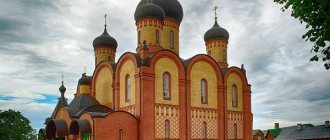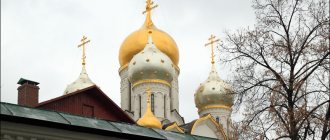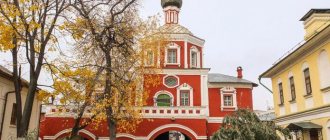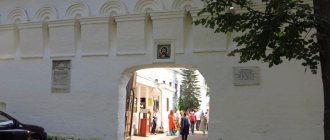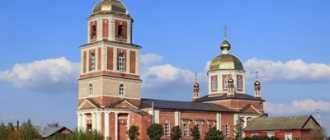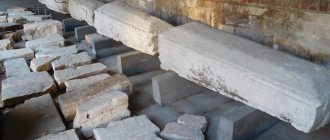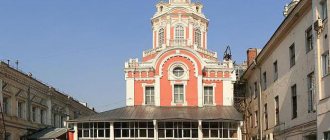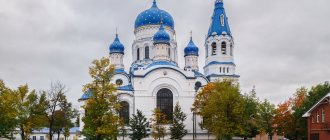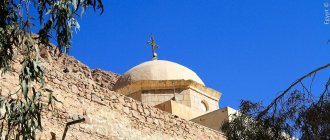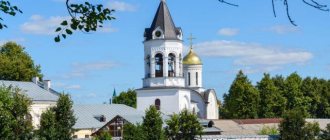General concept and meaning
The concept of “monastery” came along with Christianity to Kievan Rus from Byzantium. This state arose on the basis of Greek culture. From Greek, “monastery” means “solitary dwelling.”
In it, the monks observe a single charter. However, not everyone who comes to a monastery becomes a monk. First, he passes the test. If it ends successfully, the person is awarded tonsure. According to the rules established at the Ecumenical Council, regardless of the previous moral lifestyle, a person can enter monasticism for the correction (salvation) of the soul.
The meaning of the word “monastery” for many today means directly the community of monastics.
Monastic life
Monasticism has a long history . The first Chernetsy communities appeared in the 4th century, in the lower reaches of the Nile River and in the vicinity of Jewish Bethlehem.
When Christianity became the state religion of the Roman Empire, monasteries were built on European territory. After the baptism of Rus' by Prince Vladimir in 988, Greek monks moved to the Kyiv lands. The Kiev Pechersk Lavra becomes a famous settlement of monks. Gradually, monasticism spread throughout the Slavic lands.
Interesting! Why does the Akathist to the Guardian Angel need to be read on Mondays?
An Orthodox Christian who has decided to devote his life to prayer and ascetic deeds takes monastic vows. To achieve complete spiritual perfection, a monk overcomes 5 steps.
- The novice does not take a monastic vow, wears civilian clothes and gets used to the routine of monastic life.
- “Ryasophor” or “Rassophorus novice” renounces his worldly name and takes a vow of obedience. The robe consists of a hood and cassock. The monk carries a rosary in his hand.
- The Chernets, who after a symbolic tonsure receives a new name, is allowed to wear a cassock.
- Taking the small schema or mantle monasticism, a monk makes 5 vows: renunciation of the world, non-covetousness, celibacy, obedience and constant prayer.
- The Great Schema means complete renunciation of the earthly world and union with God.
The first Christian monasteries
A monastery is a specific place with its own way of life. The first monasteries arose in Egypt and Palestine (4th-5th centuries AD). Over time, monastic dwellings began to appear in Constantinople (the capital of Byzantium), which is mentioned in Russian chronicles as Constantinople.
The first founders of monasticism in Rus' are considered to be Anthony and Theodosius, who created the Kiev-Pechersk Monastery.
Stavropegia in the Moscow region
Some monasteries are located near the capital. These are old pygians:
- Resurrection New Jerusalem in Istra. Founded by Patriarch Nikon in the mid-17th century as a complex of holy places in Palestine.
- Iosifovo-Volotsky in the village of Teryaevo (16 km from Volokolamsk). Founded in the second half of the 15th century.
- Nikolo-Ugreshsky in Dzerzhinsky. Founded at the end of the 14th century by Dmitry Donskoy.
- Savvino-Storozhevsky 2 km from Zvenigorod. Founded at the end of the 14th century by the student of Sergius of Radonezh, monk Savva.
- Trinity-Sergius Lavra in Sergiev Posad. The largest monastery, founded by Sergius of Radonezh in the 30s of the 14th century.
Types of Christian monasteries
In Christianity there is a division into nunnery and monastery. What this means is not difficult to understand. The name depends on whether the women's or men's community lives and operates at the church temple. There are no mixed monasteries in Christianity.
Different types of monastic dwellings:
Abbey. Found in the Catholic (western) direction. Ruled by the abbot in the men's community and the abbess in the women's community. Submits to the bishop, and sometimes to the Pope personally.
Lavra. This is the largest monastic dwelling of the Orthodox (Eastern) direction. This type of monastic home is suitable exclusively for male communities.
Kinovia. Community monastery. This means that the organization has a community charter to which all its members are subject.
Compound. This is a dwelling remote from the monastery, which is located in a city or village. It is used to collect donations, receive pilgrims, and conduct housekeeping.
Deserts. The dwelling, created in the traditions of Russian Orthodoxy, is built in a secluded place away from the monastery itself.
Skit. This is a place to live for a monk who wishes to become a hermit.
Most of the monastic dwellings are under the control of diocesan bishops. Such monasteries are called diocesan. Certain Orthodox monasteries may have stauropegial status.
Men's monasteries in Moscow
Below are the active stauropegic monasteries located within the city.
Andreevsky
It is believed that the monastery was founded in the 13th century as a men’s monastery “at Vorobyovy Kruchi,” but in written evidence it is mentioned only in the middle of the 17th century. At different times, an asylum, a prison, a hospital for the mentally ill, a cemetery and an almshouse with residential buildings were created in it. Under Soviet rule, the temple was closed, and the commune of the 1st Moscow Goznak factory was located in other buildings. In 1991, a patriarchal compound was opened on the territory of the monastery; after 5 years, the monastery was completely transferred to the patriarchate. Since 2013, the monastery has been stauropegial.
Address: Andreevskaya embankment, 2.
Vysoko-Petrovsky
It is believed that on the site of the monastery at the beginning of the 14th century, under Ivan Kalita, a wooden church was founded, which later grew into a monastery. Stavropegia has experienced a lot in its lifetime: while still wooden, the monastery burned down several times, it was devastated by the Poles in 1611 and the French in 1812, and was closed under the USSR. After the expulsion of the Polish interventionists, the monastery received stauropegial status. Monastic life resumed in him in 2009.
Address: st. Petrovka, 28с2.
Donskoy
It was founded at the end of the 16th century by Tsar Fyodor Mikhailovich after the victory over the Crimean Khan Kazy-Girey: he retreated with huge losses, which was regarded as a miracle. At first, there was a small one-domed Cathedral of Our Lady of the Don, named after the icon of the same name. According to legend, this icon brought Prince Dmitry Donskoy victory at the Kulikovo Field and was moved to the camp church during the battles with the Crimean Tatars.
Under the USSR, all churches were closed, anti-religious exhibitions were held in them and a similar museum operated for some time, then the building was given to the museum of architecture at the Academy of the same name. The monastery was transferred to the patriarchate in 1991.
Address: Donskaya Square, 1с3.
Zaikonospassky
The name means “Spassky behind the icon row.” It is believed that it was founded by Tsar Boris Godunov in 1600 on the site of the monastery of St. Nicholas the Old. The first written mentions date back to 1635. First of all, the monastery is known for its educational school, which “grew” into the Slavic-Greek-Latin Academy. It was closed under the Soviet Union and work resumed only in 1992. At the same time, the process of transferring property was accompanied by a conflict with the Russian State University for the Humanities (Russian State University for the Humanities). Today, many of the premises of the monastery are rented by non-church organizations: a post office, a restaurant, the Historical and Archival Institute of the Russian State University for the Humanities.
Address: Nikolskaya street, building 7−9, building 3.
Novospassky
It was founded under Ivan III, who resettled monks here from the Kremlin monastery of the Savior on Bor. The monastery gained popularity after the Romanovs came to power. Under the USSR, the monastery was closed, a concentration camp was opened on its territory, and then the economic administration of the NKVD was opened. Some monuments were transferred to the museum at the Simonov Monastery. In 1960, the monastery began to be restored to become a museum of restoration work. In 1991, the territory was returned to the Russian Orthodox Church.
Address: Peasant Square, 10с12.
Sretensky
It was founded at the end of the 14th century by Prince Vasily I on Kuchkovo Field after a miraculous victory over Tamerlane. In the 17th century, the monastery was moved to its modern location. Initially, the monastery was supernumerary (it supported itself), but today it is stauropegic.
Address: Bolshaya Lubyanka street, 19с1.
Stavropegial Monastery
What this means will help you find out by returning to the Greek language. When literally translated, “stauropegia” means “raising the cross.” It is assigned not only to monasteries, but also to cathedrals and theological schools.
This status means that the monastery is directly subordinate to the patriarch or synod. The Stavropegic Monastery is a shrine in which the cross was erected with the patriarch’s own hand. This is the highest status.
Due to the fact that the diocese of the Orthodox Church was divided into several branches, there are different lists of stauropegic churches. Depending on their subordination, they may belong to the Orthodox Church of Russia, Ukraine, Belarus, and so on. There are such shrines in other countries, such as Estonia, Italy, USA, Germany.
Stavropegial - what is it?
The word "stauropygial" is of Greek origin. “Stauropygia” is translated as “installation (or hoisting) of the cross.” This term denotes the status that is assigned to some Orthodox monasteries. Accordingly, a monastery that has this title is called stauropegial. It could also be a cathedral or a religious educational institution. Stavropegial - what is it, what is the essence of this status? Before finding out, it is necessary to get a general understanding of Orthodox monasteries.
Donskoy Monastery - one of the stauropegic monasteries of Moscow
Modern stauropegic monasteries
The largest number of such monastic dwellings is represented in Moscow and the Moscow region.
List of men's housing in Moscow:
- Andreevsky;
- Vysoko-Petrovsky;
- Danilov;
- Donskoy;
- Zaikonospassky;
- Novospassky;
- Sretensky.
List of women's housing in Moscow:
- Alekseevsky;
- Mother of God of the Nativity;
- Zachatievsky;
- Ioanno-Predtechensky;
- Pokrovsky;
- Trinity-Odigitrievskaya hermitage.
When and where should a new stauropegic monastery be opened? What does it mean? The decision on this issue is made by the Patriarch of Moscow and All Rus' alone.
Modern patriarchal monasteries
Today there are 33 monasteries under the direct control of the patriarch.
Female stauropegic monastic communities
As of 2022, there are 18 female monastic communities in Russia under the direct control of the Moscow Patriarchate.
The most popular are:
- The capital's Marfo-Mariinskaya Convent of Mercy was founded in 1909 by Princess Elizaveta Fedorovna Romanova. Here they were engaged in guardianship, education and assistance to the poor. It received the status of stauropegia in 1992. The modern monastery houses a shelter for orphan girls and a center for working with children with cerebral palsy.
Marfo-Mariinskaya Convent - The Pokrovsky Monastery in Moscow, founded in 1635, was a men's monastery before the revolution. It was closed from 1929 to 1994. By the decision of the Holy Synod in the early 90s, it was transformed into a female stauropegic monastery. A huge number of pilgrims are attracted to the monastery by the relics of the Matrona of Moscow, transferred here in 1998.
- The Nativity Monastery is one of the oldest female monastic communities in Moscow. It was founded in 1386. Its modern history began in 1992 with the transfer of the Cathedral of the Nativity of the Blessed Virgin Mary to the Orthodox Church and receiving the status of stauropegy.
Forms of organization of monasticism
A monastery is a place where monks live. Depending on what form of organization they chose, the monastery can be with a communal charter or in the form of a hermitage.
For Christians, hermitage is a fairly developed form of monasticism. Even Jesus Christ himself spent 40 days in the desert.
The first hermits went into the desert, persecuted by the Roman authorities back in the 3rd century. Later, this form spread from Egypt to Palestine, Armenia, Gaul and throughout Europe. In Western Christianity, hermitage disappeared; it was preserved only in the Orthodox direction. Among the hermits who devoted themselves to asceticism and intense prayers, there are both men and women. The most famous hermit is Mary of Egypt from Palestine, who lived in the 6th century.
Another form of organization of monasticism is called Kinovia.
Novodevichy Convent
Article: Novodevichy Convent - the oldest Orthodox monastery for women
View of the Novodevichy Convent from Novodevichy Ponds Park
The Novodevichy Convent, built in the 16th century, was at that time located on Samsonov Meadow. Nowadays this area is called the Maiden Field. The cathedral church at the monastery was built in the likeness of the Assumption Cathedral - the “neighbor” of the Moscow Kremlin. The monastery walls and towers were built in the 16th – 17th centuries. In general, the architecture of the monastery conveys the “Moscow Baroque” style. The monastery owes its fame to the Godunov family. Boris Godunov lived here before his election as king with his sister Irina. Irina Godunova took monastic vows with the name Alexander and lived in separate chambers with a wooden tower. At the end of the 16th century. The territory of the monastery was replenished with stone walls and a dozen towers. In appearance, they resembled Kremlin buildings (there were square towers in the walls, and round ones in the corners). Their upper parts were decorated with teeth. Today the Novodevichy Convent combines both a museum and a monastery.
Charter of Cynovia
From Greek, the word means “living together,” that is, community.
The founder of the first cenobia is considered to be Saint Pachomius, who created it in 318 in Southern Egypt. As for the Russian Orthodox Church, the first communal church was created by Theodosius of Pechersk.
According to the general rule, the monks accept from the monks everything necessary for their existence. For example, food, clothes, shoes. They work for free, and all the results of their work belong to the kin. The monk, including the abbot, do not have the right to have personal property; they cannot make acts of donation or inherit anything. They have no property rights.
Monasteries
A monastery is a community of monks that has a single charter and a complex of buildings in which the monks live, services are held and supplies are stored. The word is translated from Greek as “lonely.” This community is practically divorced from worldly life: its inhabitants are completely self-sufficient: they run a household, have a vegetable garden and livestock, and engage in handicrafts, the sale of which allows them to make some profit. Also on the territory of the parish there are often miraculous icons to which pilgrims come.
Monasteries are divided into several types:
- An abbey is a Catholic monastery governed by an abbot and subject to a bishop or Pope;
- Lavra - the largest Orthodox monasteries;
- The metochion is a remote representation of the monastery. For example, in Moscow there were representations of Kolomna, Novgorod, Ryazan and other monasteries: the monks living here represented the interests of their monastery and collected money for them;
- Pustyn is a settlement remote from a city or village. Usually these were small communities that allowed a solitary lifestyle and could then grow into large monasteries. In this case, the word “hermitage” was retained in the name, for example, Ascension David’s Hermitage;
- A monastery is a secluded dwelling for one hermit.
There are also parishes:
- Kinovia or hostel. In them, monks are not allowed to have personal property: they perform labor duties for the common benefit (“obedience”), receiving everything they need from the monastery. The abbots are elected by the monks themselves;
- Idiorythms or non-dormitory. Monks differ in the presence of personal property - in fact, only the place and services are common. Monks can work and accumulate money, rectors are appointed by the diocesan bishop.
Another division concerns the receipt of content:
- The regular ones receive money for their maintenance “from above” and can only support a certain number of monks. However, the size of the content is strictly limited. Established monasteries are also divided into 3 classes depending on the amounts given out and the opportunities provided to them. The first, privileged class, among others, includes laurels and stauropegic parishes;
- Supernumerary: they are completely self-sufficient and can accept any number of monks - as many as they can support.
Rules of conduct in the monastery for a layman
The monastery is a special world. It takes time to understand all the intricacies of monastic life. Misdeeds by pilgrims are usually treated with patience, but it is better to know some rules when visiting a monastic home.
What to look for in behavior:
- When you come as a pilgrim, you need to ask for blessings for everything;
- You cannot leave the monastery without a blessing;
- all worldly sinful addictions must be left behind the walls of the monastery (alcohol, tobacco, foul language);
- conversations should only be about spiritual things, and the main words in communication are the words “forgive” and “bless”;
- You can eat food only at a common meal;
- When sitting down at the table for a meal, it is necessary to observe the order of precedence, sit silently and listen to the reading.
To plunge into the world of peace and harmony that exists in the monastery, you do not need to know all the rules of the monastic way of life. It is enough to adhere to the usual standards of behavior, which include respect for elders and restraint.
An excerpt characterizing the List of stauropegial monasteries of the Russian Orthodox Church
"Le cosaque ignorant la compagnie dans laquelle il se trouvait, car la simplicite de Napoleon n'avait rien qui put reveler a une imagination orientale la presence d'un souverain, s'entretint avec la plus extreme familiarite des affaires de la guerre actuelle" , [The Cossack, not knowing the society in which he was, because the simplicity of Napoleon had nothing that could open the presence of the sovereign to the Eastern imagination, spoke with extreme familiarity about the circumstances of the present war.] - says Thiers, recounting this episode . Indeed, Lavrushka, who got drunk and left the master without dinner, was flogged the day before and sent to the village to get chickens, where he became interested in looting and was captured by the French. Lavrushka was one of those rude, insolent lackeys who have seen all sorts of things, who consider it their duty to do everything with meanness and cunning, who are ready to do any service to their master and who cunningly guess the master’s bad thoughts, especially vanity and pettiness. Once in the company of Napoleon, whose personality he recognized very well and easily. Lavrushka was not at all embarrassed and only tried with all his heart to serve the new masters. He knew very well that it was Napoleon himself, and the presence of Napoleon could not confuse him more than the presence of Rostov or the sergeant with rods, because he had nothing that neither the sergeant nor Napoleon could deprive him of. He lied about everything that was said between the orderlies. Much of this was true. But when Napoleon asked him how the Russians thought, whether they would defeat Bonaparte or not, Lavrushka squinted and thought. He saw subtle cunning here, as people like Lavrushka always see cunning in everything, he frowned and was silent. “It means: if there is a battle,” he said thoughtfully, “and in speed, then it’s so accurate.” Well, if three days pass after that very date, then it means that this very battle will be delayed. It was translated to Napoleon as follows: “Si la bataille est donnee avant trois jours, les Francais la gagneraient, mais que si elle serait donnee plus tard, Dieu seul sait ce qui en arrivrait” [“If the battle takes place before three days, the French will win him, but if after three days, then God knows what will happen.”] – Lelorgne d’Ideville conveyed with a smile. Napoleon did not smile, although he was apparently in the most cheerful mood, and ordered these words to be repeated to himself. Lavrushka noticed this and, to cheer him up, said, pretending that he did not know who he was. “We know, you have Bonaparte, he beat everyone in the world, well, that’s another story about us...” he said, not knowing how and why in the end a boastful patriotism slipped into his words. The translator conveyed these words to Napoleon without ending, and Bonaparte smiled. “Le jeune Cosaque fit sourire son puissant interlocuteur,” [The young Cossack made his powerful interlocutor smile.] says Thiers. Having walked a few steps in silence, Napoleon turned to Berthier and said that he wanted to experience the effect that would have sur cet enfant du Don [on this child of the Don] the news that the person with whom this enfant du Don was speaking was the Emperor himself , the same emperor who wrote the immortally victorious name on the pyramids. The news was transmitted. Lavrushka (realizing that this was done to puzzle him, and that Napoleon thought that he would be afraid), in order to please the new gentlemen, immediately pretended to be amazed, stunned, bulged his eyes and made the same face that he was accustomed to when he was led around flog. “A peine l'interprete de Napoleon,” says Thiers, “avait il parle, que le Cosaque, saisi d'une sorte d'ebahissement, no profera plus une parole et marcha les yeux constamment attaches sur ce conquerant, dont le nom avait penetre jusqu'a lui, a travers les steppes de l'Orient. Toute sa loquacite s'etait subitement arretee, pour faire place a un sentiment d'admiration naive et silencieuse. Napoleon, apres l'avoir recompense, lui fit donner la liberte, comme a un oiseau qu'on rend aux champs qui l'ont vu naitre." [As soon as Napoleon’s translator said this to the Cossack, the Cossack, overcome by some kind of stupor, did not utter a single word and continued to ride, not taking his eyes off the conqueror, whose name had reached him through the eastern steppes. All his talkativeness suddenly stopped and was replaced by a naive and silent feeling of delight. Napoleon, having rewarded the Cossack, ordered that he be given freedom, like a bird that is returned to its native fields.] Napoleon rode on, dreaming of that Moscou that so occupied his imagination, a l'oiseau qu'on rendit aux champs qui l'on vu The naitre [the bird returned to its native fields] galloped to the outposts, thinking ahead of everything that had not happened and that he would tell his own people. He did not want to tell what really happened to him precisely because it seemed to him unworthy of telling. He went to the Cossacks, asked where the regiment that was in Platov’s detachment was, and in the evening he found his master Nikolai Rostov, who was standing in Yankov and had just mounted horseback to take a walk with Ilyin through the surrounding villages. He gave another horse to Lavrushka and took him with him. Princess Marya was not in Moscow and out of danger, as Prince Andrei thought. After Alpatych returned from Smolensk, the old prince seemed to suddenly come to his senses from his sleep. He ordered militiamen to be collected from the villages, to arm them, and wrote a letter to the commander-in-chief, in which he informed him of his intention to remain in the Bald Mountains to the last extremity, to defend himself, leaving it at his discretion to take or not take measures to protect the Bald Mountains, in which he would be taken one of the oldest Russian generals was captured or killed, and announced to his family that he was staying in Bald Mountains.
Seraphim-Diveevo Monastery
Article: Seraphim-Diveevo Monastery - the fourth earthly inheritance of the Mother of God
View of the Seraphim-Diveevsky Monastery
Seraphim-Diveevo Monastery is a convent founded in the 2nd half of the 18th century. At Mother Alexandra's own expense, the foundation of the Kazan Church was first laid. Pachomius, a master famous for the construction of the Sarov Desert, was in charge of its consecration as construction was completed. The church premises were equipped with 2 chapels - in the name of Archdeacon Stephen and St. Nicholas. Then the Trinity and Transfiguration Cathedrals appeared in Diveevo. The latter was built with substantial donations, because reinforced concrete was used in its construction for the first time (previously such material had not been used in the construction of shrines). But the main temple here is considered to be the Trinity Cathedral, in which the relics of Seraphim of Sarov rest. Everyone who wants to receive grace-filled help and healing specially gathers at the shrine with the relics of the monk.
Pskov-Pechersky Monastery
Article: Holy Dormition Pskov-Pechersky Monastery - the northwestern frontier of Orthodoxy
View of the buildings of the Pskov-Pechersky Monastery
The Pskov-Pechersky Monastery was founded in 1473, when the consecration of the Assumption Church, dug out of a sandy hill by the Monk Jonah, took place (it was located near the Kamenets stream). During the first 500 years of its existence, the monastery experienced many different bad events, and only under Abbot Dorotheos did it experience a period of prosperity. Already in the 20s of the 16th century. The Church of the Assumption was improved and expanded, and other churches and buildings for various purposes appeared. The construction work was managed by the sovereign clerk Misyur Munekhin. He spared no expense in establishing the monastery, which is why after his death he was buried in a cave at the monastery (previously the laity had not been buried here). The next period of prosperity of the monastery occurred during the years of Abbot Cornelius' service there. Under him, the monastery became famous as never before. Thanks to the funds of pilgrims who flocked to the courtyard in streams, the once wretched monastery was replenished with land, estates and precious deposits.
| ← RUSSIA | EUROPE → |
Kirillo-Belozersky Monastery
Article: Kirillo-Belozersky Monastery: beauty and grandeur, history and facts
View of the Kirillo-Belozersky Monastery from the Russian North National Park
The Kirillo-Belozersky Monastery is located on the shores of Lake Siverskoye. It owes its appearance to St. Cyril, who founded it in 1397. Construction began with the arrangement of a cell-cave and the installation of a wooden cross over it. In the same year, the illumination of the first shrine took place - it was a wooden church built in the name of the Dormition of the Blessed Virgin Mary. By 1427, there were about 50 monks in the monastery. In the first half of the 16th century. a new life begins at the monastery - all Moscow nobles and kings began to regularly come to it on pilgrimage. Thanks to their rich donations, the monks quickly built up the monastery with stone buildings. Its main attraction is the Assumption Cathedral. Appearing in 1497, it became the first stone building in the North. The monastery complex underwent various architectural changes until 1761.
Spaso-Preobrazhensky Monastery
Article: Seraphim-Diveevo Monastery - the fourth earthly inheritance of the Mother of God
View of the cathedrals of the Spaso-Preobrazhensky Monastery
Spaso-Preobrazhensky Monastery is a monastic monastery in Murom, founded by the passion-bearer prince Gleb. Having received the city as an inheritance, he did not want to settle among the pagans, so he decided to establish a princely court above the Oka. Having chosen a suitable place, Gleb of Murom built his first temple on it - this is how he immortalized the name of the All-Merciful Savior. Later he added a monastic monastery to it (the premises were used to educate the Murom people). According to the chronicle, the “monastery of the Savior on the forest” appeared in 1096. Since then, many clergy and miracle workers have visited its walls. Over time, the Spassky Cathedral appeared on the territory of the monastery - through its construction, Ivan the Terrible immortalized the date of the capture of Kazan. To furnish the premises of the new temple, the tsar allocated icons, church utensils and literature, and clothing for ministers. The Church of the Intercession with chambers, a bakery, a flour shed and a cookhouse was built in the second half of the 17th century.
